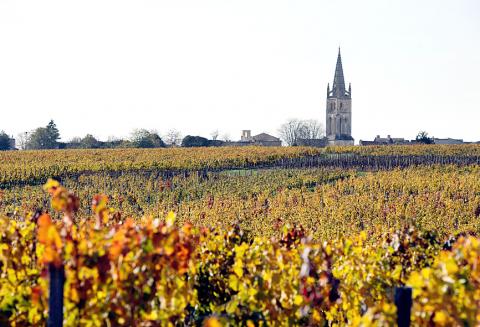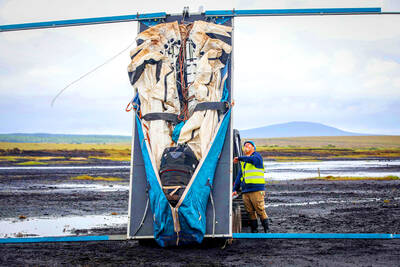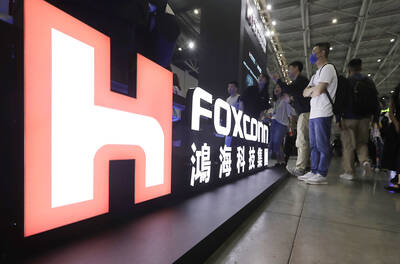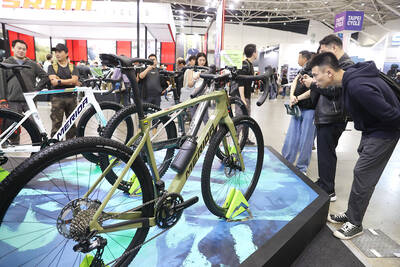An Earth-friendly future for French wine could include disease-resistant grapes, solar-powered robots and lighter packaging, as vintners innovate to slash their environmental footprint.
“We can’t keep functioning like this, polluting the Earth,” Alexis Raoux, sustainability manager for Bordeaux-based drinks group Castel, told reporters. “What feeds us is the soil. If we continue like this, in a few decades the land will be polluted and our wine won’t be any good.”
Perhaps the most dramatic green innovation in the French wine world is in the field of disease-resistant grape varieties, the culmination of more than three decades of genetic research.

Photo: AFP
“Our solution is to put forth a plant that doesn’t need any treatment,” said Didier Merdinoglu, research director at France’s INRA Colmar research center.
Concerned about the impact of pesticides and vine treatments — including the copper used by organic farmers — on soil, air and workers, Merdinoglu believes that zero treatment is the future.
Obtained through cross-breeding as opposed to genetic modification, he expects the first new grape varieties to be available from 2016, incorporating resistance to the two most commonly treated vine complaints, oidium — also known as powdery mildew — and downy mildew.
In the meantime, a new solar-powered vineyard robot called Vitirover aims to lighten wine’s impact on the soil by mowing the wild plants between vine rows without need for heavy, polluting tractors or herbicides.
Winegrowers allow this wild vegetation to grow to control vigor, improve grape and soil quality, encourage biodiversity, and protect against erosion.
Invented by Xavier David Beaulieu, co-owner of Chateau Coutet, an estate in the Bordeaux region, the 11kg, GPS-guided robot won a special jury prize at the 2012 Vinitech trade fair in Bordeaux last month.
Vintners keen to slash waste are rethinking every step, down to the label.
These days, adhesive sticker labels have replaced the glued-on variety.
“So now we have a new waste product — the backing paper from the stickers,” said Raoux, whose firm, Castel, set up a subsidiary to recycle the labeling waste from its 640 million annual bottle production.
Lighter bottles have gained ground, too, in a drive to cut wine’s carbon footprint.
Calculating that footprint is complex, but the French Vine and Wine Institute says that the heaviest impact comes from tractor fuel, glass bottles, printed cardboard boxes, electricity and shipping.
Take as an example the 43 million bottles of Champagne and sparkling wine shipped to Britain: That alone spells 38,000 tonnes of glass packaging, the British-based Waste and Resources Action Study Programme (WRAP) said.
WRAP recycling experts say that lightweight bottles could reduce that figure by between 4,000 tonnes and 11,400 tonnes — slashing wine-related carbon dioxide emissions, 35 percent of which are generated by transport.
Four years ago, Verallia, the packaging arm of Saint-Gobain — the world’s largest glass wine bottle producer — introduced a lighter range called Ecova, which today accounts for half of the firm’s 300 million-bottle Bordeaux market.
The bottles use up to 96 percent recycled glass and are 50g to 70g lighter than the previous line, Verallia regional director Didier Dumas said.
Other French wine appellations like Savoy, Alsace and the Loire Valley have made the lighter bottle their official choice, he added.
“Green” pioneers are lobbying French wine’s governing bodies to take their concerns on board.
“In France today, our bedrock is the Appellation of Origin,” said Christophe Riou, the institute’s scientific and development director. “We need to integrate environmental questions into the appellation.”
Currently, an Appellation of Origin certification denotes quality based on location, grape varieties, viticulture and winemaking methods.
Some regions like Champagne, Bordeaux and Burgundy have forged ahead, using carbon footprint studies to measure and reduce their impact.
However, that is not enough for Riou, who would like a nationwide study on the broader impact of the sector, looking beyond the carbon footprint.
For instance, a glass of French wine takes about 90 liters of water to produce, the Netherlands-based Water Footprint Network said.
“There is the water footprint, carbon footprint and the impact on biodiversity,” Riou said. “Today, we are working on this life cycle. You have to integrate all three.”

A proposed 100 percent tariff on chip imports announced by US President Donald Trump could shift more of Taiwan’s semiconductor production overseas, a Taiwan Institute of Economic Research (TIER) researcher said yesterday. Trump’s tariff policy will accelerate the global semiconductor industry’s pace to establish roots in the US, leading to higher supply chain costs and ultimately raising prices of consumer electronics and creating uncertainty for future market demand, Arisa Liu (劉佩真) at the institute’s Taiwan Industry Economics Database said in a telephone interview. Trump’s move signals his intention to "restore the glory of the US semiconductor industry," Liu noted, saying that

On Ireland’s blustery western seaboard, researchers are gleefully flying giant kites — not for fun, but in the hope of generating renewable electricity and sparking a “revolution” in wind energy. “We use a kite to capture the wind and a generator at the bottom of it that captures the power,” said Padraic Doherty of Kitepower, the Dutch firm behind the venture. At its test site in operation since September 2023 near the small town of Bangor Erris, the team transports the vast 60-square-meter kite from a hangar across the lunar-like bogland to a generator. The kite is then attached by a

Foxconn Technology Co (鴻準精密), a metal casing supplier owned by Hon Hai Precision Industry Co (鴻海精密), yesterday announced plans to invest US$1 billion in the US over the next decade as part of its business transformation strategy. The Apple Inc supplier said in a statement that its board approved the investment on Thursday, as part of a transformation strategy focused on precision mold development, smart manufacturing, robotics and advanced automation. The strategy would have a strong emphasis on artificial intelligence (AI), the company added. The company said it aims to build a flexible, intelligent production ecosystem to boost competitiveness and sustainability. Foxconn

Leading Taiwanese bicycle brands Giant Manufacturing Co (巨大機械) and Merida Industry Co (美利達工業) on Sunday said that they have adopted measures to mitigate the impact of the tariff policies of US President Donald Trump’s administration. The US announced at the beginning of this month that it would impose a 20 percent tariff on imported goods made in Taiwan, effective on Thursday last week. The tariff would be added to other pre-existing most-favored-nation duties and industry-specific trade remedy levy, which would bring the overall tariff on Taiwan-made bicycles to between 25.5 percent and 31 percent. However, Giant did not seem too perturbed by the